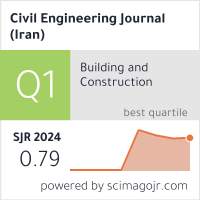Enhancing Soil Stability through Innovative Microbial-Induced Calcium Carbonate Techniques with Sustainable Ingredient
Downloads
Doi:10.28991/CEJ-2024-010-08-08
Full Text:PDF
Downloads
[2] Jalal, F. E., Xu, Y., Jamhiri, B., Memon, S. A., & Graziani, A. (2020). On the Recent Trends in Expansive Soil Stabilization Using Calcium-Based Stabilizer Materials (CSMs): A Comprehensive Review. Advances in Materials Science and Engineering, 1510969. doi:10.1155/2020/1510969.
[3] Cai, G. H., Liu, S. Y., & Zheng, X. (2019). Influence of drying-wetting cycles on engineering properties of carbonated silt admixed with reactive MgO. Construction and Building Materials, 204, 84–93. doi:10.1016/j.conbuildmat.2019.01.125.
[4] Al Qabany, A., Soga, K., & Santamarina, C. (2012). Factors Affecting Efficiency of Microbially Induced Calcite Precipitation. Journal of Geotechnical and Geoenvironmental Engineering, 138(8), 992–1001. doi:10.1061/(asce)gt.1943-5606.0000666.
[5] Jiang, N. J., Wang, Y. J., Chu, J., Kawasaki, S., Tang, C. S., Cheng, L., Du, Y. J., Shashank, B. S., Singh, D. N., Han, X. Le, & Wang, Y. Z. (2022). Bio-mediated soil improvement: An introspection into processes, materials, characterization and applications. Soil Use and Management, 38(1), 68–93. doi:10.1111/sum.12736.
[6] Osinubi, K. J., Eberemu, A. O., Ijimdiya, T. S., Yakubu, S. E., Gadzama, E. W., Sani, J. E., & Yohanna, P. (2020). Review of the use of microorganisms in geotechnical engineering applications. SN Applied Sciences, 2, 207. doi:10.1007/s42452-020-1974-2.
[7] Mitchell, J. K., & Santamarina, J. C. (2005). Biological Considerations in Geotechnical Engineering. Journal of Geotechnical and Geoenvironmental Engineering, 131(10), 1222–1233. doi:10.1061/(asce)1090-0241(2005)131:10(1222).
[8] Ivanov, V., Stabnikov, V., Stabnikova, O., & Ahmed, Z. (2020). Biocementation technology for construction of artificial oasis in sandy desert. Journal of King Saud University - Engineering Sciences, 32(8), 491–494. doi:10.1016/j.jksues.2019.07.003.
[9] Sorum, M. G., & Kalita, A. (2023). Effect of Bio-Cementation with Rice Husk Ash on Permeability of Silty Sand. Civil Engineering Journal (Iran), 9(11), 2854–2867. doi:10.28991/CEJ-2023-09-11-016.
[10] Cheng, G., Lin, H., Chaichi, A., Gartia, M. R., Park, J. S., & Sheikh, E. (2023). Mechanical Behavior and Biogeochemical Reactions of a Fine-Grained Soil Treated by Microbially Induced Carbonate Precipitation. Journal of Materials in Civil Engineering, 35(4), 4023023. doi:10.1061/(asce)mt.1943-5533.0004687.
[11] Nasser, A. A., Sorour, N. M., Saafan, M. A., & Abbas, R. N. (2022). Microbially-Induced-Calcite-Precipitation (MICP): A biotechnological approach to enhance the durability of concrete using Bacillus pasteurii and Bacillus sphaericus. Heliyon, 8(7), e09879. doi:10.1016/j.heliyon.2022.e09879.
[12] Fouladi, A. S., Arulrajah, A., Chu, J., & Horpibulsuk, S. (2023). Application of Microbially Induced Calcite Precipitation (MICP) technology in construction materials: A comprehensive review of waste stream contributions. Construction and Building Materials, 388, 131546. doi:10.1016/j.conbuildmat.2023.131546.
[13] Demenev, A. D., Khmurchik, V. T., Maksimovich, N. G., Demeneva, E. P., & Sedinin, A. M. (2021). Improvement of sand properties using biotechnological precipitation of calcite cement (CaCO3). Environmental Earth Sciences, 80(17), 1–13. doi:10.1007/s12665-021-09818-w.
[14] Naveed, M., Duan, J., Uddin, S., Suleman, M., Hui, Y., & Li, H. (2020). Application of microbially induced calcium carbonate precipitation with urea hydrolysis to improve the mechanical properties of soil. Ecological Engineering, 153, 105885. doi:10.1016/j.ecoleng.2020.105885.
[15] Pacheco, V. L., Bragagnolo, L., Reginatto, C., & Thomé, A. (2022). Microbially Induced Calcite Precipitation (MICP): Review from an Engineering Perspective. Geotechnical and Geological Engineering, 40(5), 2379–2396. doi:10.1007/s10706-021-02041-1.
[16] Li, X., Zhang, C., Xiao, H., Jiang, W., Qian, J., & Li, Z. (2021). Reducing Compressibility of the Expansive Soil by Microbiological-Induced Calcium Carbonate Precipitation. Advances in Civil Engineering, 2021, 8818771. doi:10.1155/2021/8818771.
[17] Chittoori, B. C. S., Rahman, T., & Burbank, M. (2021). Microbial-Facilitated Calcium Carbonate Precipitation as a Shallow Stabilization Alternative for Expansive Soil Treatment. Geotechnics, 1(2), 558–572. doi:10.3390/geotechnics1020025.
[18] Tian, X., Xiao, H., Li, Z., Li, Z., Su, H., & Ouyang, Q. (2022). Experimental Study on the Strength Characteristics of Expansive Soils Improved by the MICP Method. Geofluids, 2022, 1-20. doi:10.1155/2022/3089820.
[19] Tiwari, N., & Satyam, N. (2024). Indigenous Bacteria-Driven Eco-Friendly Soil Stabilization: A Bioinspired Approach Through Microbially Induced Calcite Precipitation for Sustainable Infrastructure Development. Indian Geotechnical Journal, 1-17. doi:10.1007/s40098-023-00864-8.
[20] Tian, X., Xiao, H., Su, H., & Ouyang, Q. (2024). Experimental study on creep and long-term strength characteristics of expansive soil improved by the MICP method. Arabian Journal of Geosciences, 17(6), 202. doi:10.1007/s12517-024-12009-z.
[21] Fu, T., Saracho, A. C., & Haigh, S. K. (2023). Microbially induced carbonate precipitation (MICP) for soil strengthening: A comprehensive review. Biogeotechnics, 1(1), 100002. doi:10.1016/j.bgtech.2023.100002.
[22] Yang, Z., Liu, L., Dong, Y., & Gao, Z. (2024). Comparative study on the effect of SRB and Sporosarcina pasteurii on the MICP cementation and solidification of lead–zinc tailings. Chemical Engineering Journal, 495, 153446. doi:10.1016/j.cej.2024.153446.
[23] Gharaibeh, N., AlAjlouni, M., & Al-Rousan, A. (2019). Olive mill wastewater as cutting fluids: Effect on surface roughness of aluminum. Jordan Journal of Mechanical and Industrial Engineering, 12(3), 161–166.
[24] Meenambigai, P., Vijayaraghavan, R., Gowri, R. S., Rajarajeswari, P., & Prabhavathi, P. (2016). Biodegradation of Heavy Metals – A Review. International Journal of Current Microbiology and Applied Sciences, 5(4), 375–383. doi:10.20546/ijcmas.2016.504.045.
[25] Yu, T., Souli, H., Péchaud, Y., & Fleureau, J. M. (2022). Optimizing protocols for microbial induced calcite precipitation (MICP) for soil improvement–a review. European Journal of Environmental and Civil Engineering, 26(6), 2218–2233. doi:10.1080/19648189.2020.1755370.
[26] Narasimha Rao, A. V., & Chittaranjan, M. (2010). Harmful effects of certain Industrial wastes on geotechnical properties of soils - A review. Nature Environment and Pollution Technology, 9(4), 799–804.
[27] Tang, C. S., Yin, L. Yang, Jiang, N. Jun, Zhu, C., Zeng, H., Li, H., & Shi, B. (2020). Factors affecting the performance of microbial-induced carbonate precipitation (MICP) treated soil: a review. Environmental Earth Sciences, 79(5), 1–23. doi:10.1007/s12665-020-8840-9.
[28] Tiwari, N., Satyam, N., & Sharma, M. (2021). Micro-mechanical performance evaluation of expansive soil biotreated with indigenous bacteria using MICP method. Scientific Reports, 11(1), 10324. doi:10.1038/s41598-021-89687-2.
[29] Osinubi, K. J., Eberemu, A. O., Gadzama, E. W., & Ijimdiya, T. S. (2019). Plasticity characteristics of lateritic soil treated with Sporosarcina pasteurii in microbial-induced calcite precipitation application. SN Applied Sciences, 1(8), 829. doi:10.1007/s42452-019-0868-7.
[30] Wani, K. M. N. S., & Mir, B. A. (2019). Effect of Biological Cementation on the Mechanical Behaviour of Dredged Soils with Emphasis on Micro-structural Analysis. International Journal of Geosynthetics and Ground Engineering, 5(4), 32. doi:10.1007/s40891-019-0183-9.
[31] Wen, K., Li, Y., Liu, S., Bu, C., & Li, L. (2021). Evaluation of MICP treatment through EC and pH tests in urea hydrolysis process. Environmental Geotechnics, 8(4), 274–281. doi:10.1680/jenge.17.00108.
[32] Oyediran, I. A., & Ayeni, O. O. (2020). Comparative effect of microbial induced calcite precipitate, cement and rice husk ash on the geotechnical properties of soils. SN Applied Sciences, 2(7). doi:10.1007/s42452-020-2956-0.
[33] Moradi, G., Shafaghatian, S., & Katebi, H. (2022). Effect of Chemical and Biological Stabilization on the Resilient Modulus of Clay Subgrade Soil. International Journal of Pavement Research and Technology, 15(2), 415–432. doi:10.1007/s42947-021-00029-x.
[34] Islam, M. T., Chittoori, B. C. S., & Burbank, M. (2020). Evaluating the Applicability of Biostimulated Calcium Carbonate Precipitation to Stabilize Clayey Soils. Journal of Materials in Civil Engineering, 32(3), 4019369. doi:10.1061/(asce)mt.1943-5533.0003036.
[35] Rahman, T. (2018). Studying the Use of Microbial Induced Calcite Precipitation as a Shallow Stabilization Alternative to Treat Expansive Soils. Master Thesis, Boise State University, Boise, United States.
[36] Su, H., Xiao, H., Li, Z., Tian, X., Luo, S., Yu, X., & Ouyang, Q. (2022). Experimental Study on Microstructure Evolution and Fractal Features of Expansive Soil Improved by MICP Method. Frontiers in Materials, 9. doi:10.3389/fmats.2022.842887.
[37] Xiao, J. Z., Wei, Y. Q., Cai, H., Wang, Z. W., Yang, T., Wang, Q. H., & Wu, S. F. (2020). Microbial-Induced Carbonate Precipitation for Strengthening Soft Clay. Advances in Materials Science and Engineering, 8140724. doi:10.1155/2020/8140724.
[38] Hammes, F., Seka, A., Van Hege, K., Van De Wiele, T., Vanderdeelen, J., Siciliano, S. D., & Verstraete, W. (2003). Calcium removal from industrial wastewater by bio-catalytic CaCO3 precipitation. Journal of Chemical Technology and Biotechnology, 78(6), 670–677. doi:10.1002/jctb.840.
[39] Pradhan, R. C., Nanda, S., Mohapatra, B. G., Pal, S. S., & Beriha, B. (2023). Utilization of enzymatic soil as a subgrade material. Arabian Journal of Geosciences, 16(8), 1–19. doi:10.1007/s12517-023-11579-8.
[40] Cui, M. J., Chu, J., & Lai, H. J. (2024). Optimization of one-phase-low-pH enzyme-induced carbonate precipitation method for soil improvement. Acta Geotechnica, 19(3), 1611–1625. doi:10.1007/s11440-023-02175-x.
[41] Soon, N. W., Lee, L. M., Khun, T. C., & Ling, H. S. (2013). Improvements in engineering properties of soils through microbial-induced calcite precipitation. KSCE Journal of Civil Engineering, 17(4), 718–728. doi:10.1007/s12205-013-0149-8.
[42] Arpajirakul, S., Pungrasmi, W., & Likitlersuang, S. (2021). Efficiency of microbially-induced calcite precipitation in natural clays for ground improvement. Construction and Building Materials, 282, 122722. doi:10.1016/j.conbuildmat.2021.122722.
[43] Kamaraj, N., Janani, V., Ravichandran, P. T., Nigitha, D., & Priyanka, K. (2016). Study on Improvement of Soil Behaviour by Bio-Stabilsation Method. Indian Journal of Science and Technology, 9(33), 5–9. doi:10.17485/ijst/2016/v9i33/95979.
[44] Teng, F., Sie, Y. C., & Ouedraogo, C. (2021). Strength improvement in silty clay by microbial-induced calcite precipitation. Bulletin of Engineering Geology and the Environment, 80(8), 6359–6371. doi:10.1007/s10064-021-02308-0.
[45] Pei, D., Liu, Z., Wu, W., & Hu, B. (2021). Transcriptome analyses reveal the utilization of nitrogen sources and related metabolic mechanisms of Sporosarcina pasteurii. PLoS ONE, 16(2), 1–22. doi:10.1371/journal.pone.0246818.
[46] AL-Eitan, L. N., Alkhatib, R. Q., Mahawreh, B. S., Tarkhan, A. H., Malkawi, H. I., & Rusan, M. J. (2021). The Effects of Olive Mill Wastewater on Soil Microbial Populations. Jordan Journal of Biological Sciences, 14(3), 545–549. doi:10.54319/jjbs/140321.
- Authors retain all copyrights. It is noticeable that authors will not be forced to sign any copyright transfer agreements.
- This work (including HTML and PDF Files) is licensed under a Creative Commons Attribution 4.0 International License.![]()















